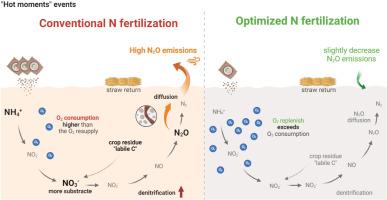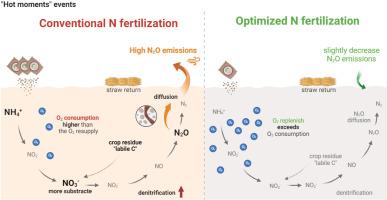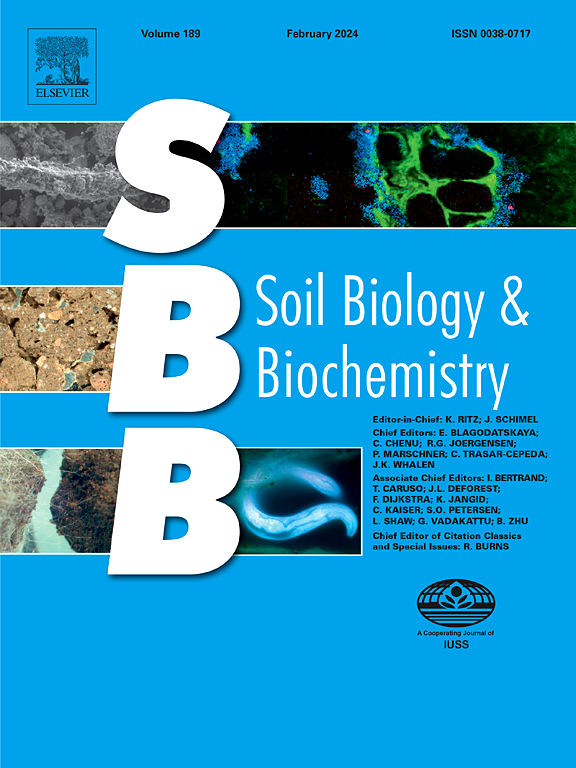秸秆还田在土壤氧气动力学中的不同作用阐明了其对土壤一氧化二氮排放的混杂效应
IF 9.8
1区 农林科学
Q1 SOIL SCIENCE
引用次数: 0
摘要
秸秆还田对土壤中氧化亚氮(N2O)排放的不同影响需要阐明解释原位条件不一致的内在机制和因素。我们在氮肥施用和秸秆管理不同制度下的长期试验基础上进行了一项田间试验,并辅以可视化氧气动态成像的实验室培养试验。在田间试验中,我们对土壤基质氧气(O2)、一氧化二氮浓度以及一氧化二氮 "热点 "事件期间的通量进行了每小时一次的高时间分辨率测量。我们发现,在传统的高氮输入(Ncon)条件下,秸秆还田增加了 32.7% 的一氧化二氮累积排放量,但在优化氮输入(Nopt)条件下,秸秆还田对一氧化二氮排放量没有影响。原位 O2 含量和可视化 O2 时空分布的进一步小宇宙实验表明,长期秸秆还田增加了孔隙度和土壤中的 O2 含量,通过改善土壤孔隙结构和 "热时刻 "的通气性,减少了低氮基质条件下的 N2O 排放。与此相反,秸秆还田则会在氮基质过剩时,通过建立短期氧气耗竭区和引发缺氧微地的反硝化作用来增加一氧化二氮的排放。虽然秸秆还田在不同的氮施用率下对一氧化二氮排放的影响不一致,但在 "热时刻 "事件中,秸秆还田持续降低了土壤基质中的一氧化二氮浓度,这表明秸秆还田增加了土壤基质中产生的一氧化二氮向土壤表面的迁移。我们的研究强调了秸秆还田在土壤氧气动力学中的多方面作用,即在短期土壤微观尺度上刺激氧气消耗,但在长期土壤中观尺度上增加土壤孔隙度。这就解释了秸秆管理对土壤 N2O 在原位产生和运输的混杂效应,并强调了优化氮肥施用对减少秸秆还田时 "热时刻 "的 N2O 排放的重要性。本文章由计算机程序翻译,如有差异,请以英文原文为准。


The divergent role of straw return in soil O2 dynamics elucidates its confounding effect on soil N2O emission
The divergent effects of straw returns on nitrous oxide (N2O) emissions from soil require elucidation of the underlying mechanisms and factors that explain the inconsistency in in-situ conditions. We conducted a field experiment based on a long-term trial under different regimes of nitrogen (N) fertilization and straw management, complemented by laboratory incubation experiments involving visualized O2 dynamics imaging. In the field trial, we performed hourly basis high-time-resolution measurements of soil matrix oxygen (O2), N2O concentrations and fluxes during N2O “hot moment” events. We found that straw return increased cumulative N2O emissions by 32.7% under conventional high N input (Ncon), but showed no effect on N2O emission under optimized N input (Nopt). In situ O2 content and further microcosm experiments with visualized O2 spatiotemporal distribution suggested that long-term straw return increases porosity and soil O2 content, which reduced N2O emission under low N substrate conditions by improving soil pore structure and aeration during “hot moment” events. By contrast, straw return increased N2O emission via creating short-term O2 depletion zone and triggering denitrification in anoxic microsites when excess N substrate was available. Although straw return showed inconsistent effects on N2O emission under different N application rates, it consistently decreased N2O concentration in the soil matrix during the "hot moment" events, suggesting that straw return increases the transport of the produced N2O in soil matrix to the soil surface. Our study underscores the multifaceted role of straw return in soil O2 dynamics, i.e., stimulating O2 consumption in a short-term microscale of soil, but increasing soil porosity in a long-term mesoscale of soil. This explains the confounding effects of straw management on the production and transportation of soil N2O in situ and emphasizes the importance of optimized N fertilization for reducing the “hot moment” N2O emissions when straw is incorporated.
求助全文
通过发布文献求助,成功后即可免费获取论文全文。
去求助
来源期刊

Soil Biology & Biochemistry
农林科学-土壤科学
CiteScore
16.90
自引率
9.30%
发文量
312
审稿时长
49 days
期刊介绍:
Soil Biology & Biochemistry publishes original research articles of international significance focusing on biological processes in soil and their applications to soil and environmental quality. Major topics include the ecology and biochemical processes of soil organisms, their effects on the environment, and interactions with plants. The journal also welcomes state-of-the-art reviews and discussions on contemporary research in soil biology and biochemistry.
 求助内容:
求助内容: 应助结果提醒方式:
应助结果提醒方式:


